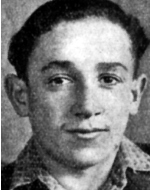Nachum, son of Miriam (nee Schwartz) and Joseph, was born on July 16, 1939, two weeks after the beginning of World War II, in Poland, in the town of Brody in Ternopol District, Galicia. In July 1942, the first Aktion took place, and the Jews were taken to the Belzec extermination camp, where they were forced to work in a factory, In December 1942, the second Aktion took place, so all of Nachum’s family – his parents, his younger brother and sister – were taken to Belzec, and he remained in his orphanage. In the following months Nachum hid with his friend in the Brody ghetto, hiding outside to search for food in one of the villages, and if it was too late to return to the ghetto they would remain in hiding in the city where they hid in a deserted house with several other young people. After he was discovered he was returned to the ghetto and Nora, but miraculously survived and succeeded in escaping with his good friend to the forest, alone and orphaned, destitute and starving, Nahum wandered for many days. From time to time, when he heard anti-Semitic statements from farmers in the area, Nahum fled from place to place and from forest to forest, but in all his years of wandering he kept his Jewishness. At the age of Bar Mitzvah, Nachum arrived at an orphanage in Lublin, where he remained until 1944. After a year in the orphanage in Lublin, which also had a ghetto and began the deportation of Jews, Nahum decided to reach his uncle in Eretz Yisrael. After many hardships, he reached the Feldenfing refugee camp in Germany, on the banks of Lake Sternberg. In the past it was a camp of the Hitler Jugend, and now it was a place for the survivors of the “death marches” and the illegal immigrants to Palestine. From there Nachum arrived at the Salon de Provence in France, and two weeks later sailed from Marseille port on the illegal immigrant ship “The Unknown Immigrant” on his way to Israel. The ship, which was purchased in Sweden by the Mossad le-Aliyah Bet of the Haganah, sailed on February 3, 1947, carrying 794 immigrants, all of them youth, Zionist movements in Europe and a group from Morocco. On February 15, 1947, the ship was attacked by British destroyers and forced to stop. The British threw gas bombs and raised soldiers on deck. At the end of a violent clash, the immigrants surrendered, and the ship was towed to the port of Haifa. The immigrants were taken to deportation ships and taken to Cyprus. Nahum was forced to stay in the camp until the end of the Mandate, and only arrived in Israel in 1948. Here he was absorbed in the “Youth Company B” in the workers’ farm in Afula. After less than 18 years, he volunteered for the Palmach, where he joined the 6th Battalion (“Jerusalem”) of the Harel Brigade, the 10th Brigade of the Haganah, and his goal was to avenge his people and liberate his homeland. During Operation “Dani”, which Israel initiated in July 1948 to open the road to Jerusalem, another operation, known as “Miki,” was carried out, including the large Jordanian compound in Latrun, which blocked the road to Jerusalem and was perceived as a threat to the “Burma Road” , The bypass road to the capital, which was opened a few weeks earlier, this time the site was attacked by the 4th and 6th Brigade Fighters of the Harel Brigade, who was injured a few days earlier (17.7.1948) from Sha’ar Hagai and managed to capture several Jordanian outposts that were located between the villages of Deir Ayub and Yalu (today in the Canadian park), but the Jordanians opened In a Gaza counterattack that included combat armored vehicles with machine guns and machine guns,And the fighters of the Palmach were forced to retreat in a difficult battle.In spite of the failure of the attack, at the end of Operation “Danny” the Jordanian army was called in the Latrun compounds The nearby “Burma Road” remained the life and rescue route of besieged Hebrew Jerusalem, On November 11, 1950, after the military rabbinate collected the remains of the soldiers from the battle, they were brought to rest in a mass grave in the military cemetery on Mount Herzl in Jerusalem. , Helen Kaminski, commemorated his life story and his special character in her book “Sarid that did not survive: The Chronicles of Noyek – Nahum Horowitz.” Space is a “last scion.” The last survivor of the Holocaust is a survivor of the last of their nuclear family (parents, brothers, sisters, sons and daughters) who experienced the Holocaust in the ghettos and / or the concentration camps and / or in flight and hiding in territories occupied by the Nazis and / Or in combat alongside members of the underground movements or partisans in the Nazi-occupied territories who immigrated to Israel during or after World War II, wore uniforms and fell in the Israeli army.
